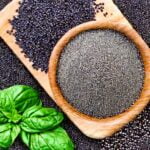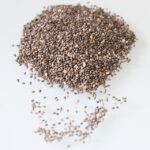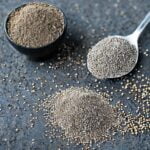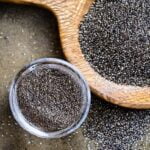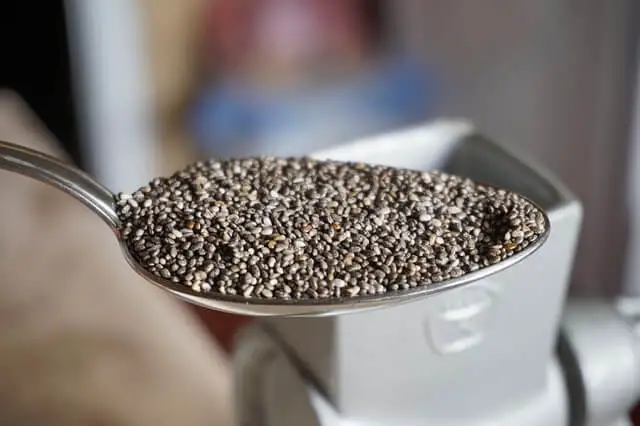
Chia seeds have grown in popularity in recent years as a superfood. When you buy them, they come packaged in their raw and dry form. But is it safe to eat them this way, or is this the way to eat them?
In this post, we will explore the question of whether or not it is safe to eat raw chia seeds, whether it’s best to eat them raw, as well as some considerations to keep in mind when consuming them.
- What are Chia Seeds?
- Can You Eat Chia Seeds Raw?
- Considerations When Eating Raw Chia Seeds
- Benefits of Eating Raw Chia Seeds
- How to Eat Raw Chia Seeds
- Final Thoughts
What are Chia Seeds?
Chia seeds are small, nutty-tasting seeds that are packed with nutrients and are often used in a variety of dishes, including smoothies, oatmeal, yogurt, and baked goods. They can also be eaten on their own as a snack or added to salads and other dishes for a crunchy texture and additional nutrition.
Can You Eat Chia Seeds Raw?
So, can you eat raw chia seeds? The short answer is yes, you can eat raw chia seeds. There are no known toxicities or adverse effects associated with consuming raw chia seeds, and they can be a nutritious and convenient addition to your diet.
However, it is important to consume them in moderation and to drink plenty of water when consuming them, as chia seeds have the ability to absorb liquid and expand in size. This can lead to dehydration if not properly hydrated, and may cause digestive issues if consumed in large quantities. You might want to start with just 1 tsp of chia seeds everyday, and then increase this amount as you are comfortable, as outlined in How Much Chia Seeds Should You Eat a Day.
It is also worth noting that chia seeds may not provide the same health benefits when eaten raw as they do when they are soaked or ground. When soaked in liquid, chia seeds can form a gel-like substance that can help to slow down the absorption of sugars and improve digestion. (Learn more at Can You Eat Chia Seeds Without Soaking?)
Grinding chia seeds can also make them more easily digestible and improve the absorption of their nutrients. Studies have found that the absorption of Omega-3s from chia seeds may be higher when the chia seeds are either soaked in water or ground first before eating them.
However, these methods require more work and preparation, so it is important to consider your own needs and preferences when deciding whether or not to eat raw chia seeds.
Considerations When Eating Raw Chia Seeds
Here is a list of the things to consider when eating raw chia seeds, as previously mentioned.
- Risk of digestive issues: While there are no known toxicities or adverse effects associated with consuming raw chia seeds, it is possible that they may cause digestive issues if consumed in large quantities. Some people may experience bloating, gas, or constipation when consuming chia seeds, especially if they are not used to eating high-fiber foods. It is a good idea to start with a small amount of chia seeds and gradually increase the amount as needed to allow your body to adjust.
- Potential for allergies: Like any food, chia seeds can cause allergic reactions in some people. Symptoms of a chia seed allergy may include hives, itching, swelling, difficulty breathing, and anaphylaxis. If you have a known allergy to chia seeds or are concerned about the potential for an allergic reaction, it is important to speak with a healthcare professional before consuming them.
- Chia seeds may not provide the same benefits when eaten raw: While chia seeds are a nutritious food when eaten raw, they may not provide the same benefits as they do when soaked or ground. Soaking chia seeds in liquid can help to improve digestion and the absorption of nutrients, while grinding them can make them more easily digestible. It is important to consider your own dietary needs and preferences when deciding whether or not to eat raw chia seeds.
Benefits of Eating Raw Chia Seeds
One of the main benefits of raw chia seeds is their high fiber content. Chia seeds are a good source of both soluble and insoluble fiber, with about 10 grams of fiber per ounce (28 grams). Soluble fiber can help to lower cholesterol and regulate blood sugar levels, while insoluble fiber helps to promote regular bowel movements and prevent constipation.
In addition to fiber, chia seeds are a good source of protein, with about 4 grams per ounce. They are also rich in essential fatty acids, including omega-3s, which are important for heart health and brain function.
When eaten raw, chia seeds can provide these nutrients as well as a variety of other vitamins and minerals, including calcium, manganese, and phosphorus. They are low in calories and have a relatively low glycemic index, making them a suitable choice for people with diabetes or those looking to manage their blood sugar levels.
However, as mentioned earlier, there may be even greater benefits to either soaking chia seeds in water overnight or grinding them before consuming them. This is because these methods will increase their digestibility. (See Chia Seeds Soaked in Water Overnight Benefits)
How to Eat Raw Chia Seeds
There are many ways to consume raw chia seeds:
- As a snack: Raw chia seeds can be eaten on their own as a snack or mixed with other ingredients, such as nuts or dried fruit, for added flavor and texture.
- In smoothies: Raw chia seeds can be added to smoothies for a crunchy texture and added nutrition. They can be mixed with a variety of ingredients, including fruits, vegetables, nuts, and seeds, to create a healthy and delicious smoothie.
- In oatmeal: Raw chia seeds can be mixed into oatmeal or other hot cereals for added texture and nutrition. They can also be mixed with yogurt and fruit for a healthy and satisfying breakfast.
- In baked goods: Raw chia seeds can be used as a replacement for eggs in some baked goods, such as muffins and breads. They can also be mixed into the batter or dough for added texture and nutrition.
- In salads: Raw chia seeds can be added to salads for a crunchy texture and added nutrition. They can be mixed with a variety of ingredients, including vegetables, fruits, nuts, and seeds, to create a healthy and satisfying salad.
Overall, there are many ways to consume raw chia seeds and incorporate them into your diet. You can find even more ways at How to Consume Chia Seeds.
Can You Eat Dry Chia Seeds in Yogurt?
Yes, you can eat dry chia seeds in yogurt. Chia seeds are a nutritious and convenient addition to yogurt, as they provide a crunchy texture and a variety of health benefits.
Chia seeds are a good source of fiber, with about 10 grams per ounce (28 grams). They are also rich in essential fatty acids, including omega-3s, and are a good source of protein, with about 4 grams per ounce. In addition to these nutrients, chia seeds are a source of various vitamins and minerals, including calcium, manganese, and phosphorus.
When eaten in yogurt, chia seeds can help to add texture and flavor to the dish, as well as provide additional nutrition. They can be added to plain or flavored yogurt and can be mixed in with fruit, nuts, or other toppings for added flavor and texture. (See How to Eat Chia Seeds with Yogurt)
It is important to note that chia seeds have the ability to absorb liquid and expand in size, so it is a good idea to drink plenty of water when consuming them. They may also cause digestive issues if consumed in large quantities, so it is a good idea to start with a small amount and gradually increase the amount as needed.
Overall, chia seeds can be a healthy and tasty addition to yogurt, as long as they are consumed in moderation and in combination with a balanced diet.
Final Thoughts
In conclusion, raw chia seeds can be a nutritious and convenient addition to your diet, but it is important to consume them in moderation and to drink plenty of water when consuming them. There are no known concerns or adverse effects associated with consuming raw chia seeds.
It is also worth considering your own dietary needs and preferences when deciding whether or not to eat raw chia seeds, as they may not provide the same benefits when eaten raw as they do when soaked or ground. Overall, raw chia seeds can be a healthy and tasty addition to your diet, as long as they are consumed in a balanced and mindful way.
Lance has been passionate about the plant-based diet and we have been following a whole food plant-based diet for over 5 years. We focus on health, natural healing, weight management, animal rights, and the health of the planet and environment by focusing on whole plant-based foods and sustainable practices.
Learn more at the About Me page and follow on social media at the links below.

